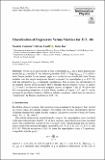Classification of Degenerate Verma Modules for E(5, 10)
Author(s)
Cantarini, Nicoletta; Caselli, Fabrizio; Kac, Victor
DownloadPublished version (728.7Kb)
Publisher with Creative Commons License
Publisher with Creative Commons License
Creative Commons Attribution
Terms of use
Metadata
Show full item recordAbstract
<jats:title>Abstract</jats:title><jats:p>Given a Lie superalgebra <jats:inline-formula><jats:alternatives><jats:tex-math>$${\mathfrak {g}}$$</jats:tex-math><mml:math xmlns:mml="http://www.w3.org/1998/Math/MathML">
<mml:mi>g</mml:mi>
</mml:math></jats:alternatives></jats:inline-formula> with a subalgebra <jats:inline-formula><jats:alternatives><jats:tex-math>$${\mathfrak {g}}_{\ge 0}$$</jats:tex-math><mml:math xmlns:mml="http://www.w3.org/1998/Math/MathML">
<mml:msub>
<mml:mi>g</mml:mi>
<mml:mrow>
<mml:mo>≥</mml:mo>
<mml:mn>0</mml:mn>
</mml:mrow>
</mml:msub>
</mml:math></jats:alternatives></jats:inline-formula>, and a finite-dimensional irreducible <jats:inline-formula><jats:alternatives><jats:tex-math>$${\mathfrak {g}}_{\ge 0}$$</jats:tex-math><mml:math xmlns:mml="http://www.w3.org/1998/Math/MathML">
<mml:msub>
<mml:mi>g</mml:mi>
<mml:mrow>
<mml:mo>≥</mml:mo>
<mml:mn>0</mml:mn>
</mml:mrow>
</mml:msub>
</mml:math></jats:alternatives></jats:inline-formula>-module <jats:italic>F</jats:italic>, the induced <jats:inline-formula><jats:alternatives><jats:tex-math>$${\mathfrak {g}}$$</jats:tex-math><mml:math xmlns:mml="http://www.w3.org/1998/Math/MathML">
<mml:mi>g</mml:mi>
</mml:math></jats:alternatives></jats:inline-formula>-module <jats:inline-formula><jats:alternatives><jats:tex-math>$$M(F)={\mathcal {U}}({\mathfrak {g}})\otimes _{{\mathcal {U}}({\mathfrak {g}}_{\ge 0})}F$$</jats:tex-math><mml:math xmlns:mml="http://www.w3.org/1998/Math/MathML">
<mml:mrow>
<mml:mi>M</mml:mi>
<mml:mrow>
<mml:mo>(</mml:mo>
<mml:mi>F</mml:mi>
<mml:mo>)</mml:mo>
</mml:mrow>
<mml:mo>=</mml:mo>
<mml:mi>U</mml:mi>
<mml:mrow>
<mml:mo>(</mml:mo>
<mml:mi>g</mml:mi>
<mml:mo>)</mml:mo>
</mml:mrow>
<mml:msub>
<mml:mo>⊗</mml:mo>
<mml:mrow>
<mml:mi>U</mml:mi>
<mml:mo>(</mml:mo>
<mml:msub>
<mml:mi>g</mml:mi>
<mml:mrow>
<mml:mo>≥</mml:mo>
<mml:mn>0</mml:mn>
</mml:mrow>
</mml:msub>
<mml:mo>)</mml:mo>
</mml:mrow>
</mml:msub>
<mml:mi>F</mml:mi>
</mml:mrow>
</mml:math></jats:alternatives></jats:inline-formula> is called a finite Verma module. In the present paper we classify the non-irreducible finite Verma modules over the largest exceptional linearly compact Lie superalgebra <jats:inline-formula><jats:alternatives><jats:tex-math>$${\mathfrak {g}}=E(5,10)$$</jats:tex-math><mml:math xmlns:mml="http://www.w3.org/1998/Math/MathML">
<mml:mrow>
<mml:mi>g</mml:mi>
<mml:mo>=</mml:mo>
<mml:mi>E</mml:mi>
<mml:mo>(</mml:mo>
<mml:mn>5</mml:mn>
<mml:mo>,</mml:mo>
<mml:mn>10</mml:mn>
<mml:mo>)</mml:mo>
</mml:mrow>
</mml:math></jats:alternatives></jats:inline-formula> with the subalgebra <jats:inline-formula><jats:alternatives><jats:tex-math>$${\mathfrak {g}}_{\ge 0}$$</jats:tex-math><mml:math xmlns:mml="http://www.w3.org/1998/Math/MathML">
<mml:msub>
<mml:mi>g</mml:mi>
<mml:mrow>
<mml:mo>≥</mml:mo>
<mml:mn>0</mml:mn>
</mml:mrow>
</mml:msub>
</mml:math></jats:alternatives></jats:inline-formula> of minimal codimension. This is done via classification of all singular vectors in the modules <jats:italic>M</jats:italic>(<jats:italic>F</jats:italic>). Besides known singular vectors of degree 1,2,3,4 and 5, we discover two new singular vectors, of degrees 7 and 11. We show that the corresponding morphisms of finite Verma modules of degree 1,4,7, and 11 can be arranged in an infinite number of bilateral infinite complexes, which may be viewed as “exceptional” de Rham complexes for <jats:italic>E</jats:italic>(5, 10).</jats:p>
Date issued
2021Department
Massachusetts Institute of Technology. Department of MathematicsJournal
Communications in Mathematical Physics
Publisher
Springer Science and Business Media LLC